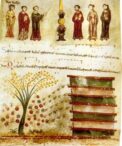Adapted from the Catholic Encyclopedia, Wikipedia, and other sources.
The so-called Exultet is arguably one of the most glorious and beautiful of hymns of the liturgy. The Roman Missal gives the title simply as Praeconium Paschale, which translates literally as The Pascal Praise. It is sung by the deacon (or priest) in the liturgy of Holy Saturday, in praise of the paschal candle, which is, of course, a type of Our Lord.
The words of the Praeconium Paschale were not always the same, and so it did not always start with the word Exultet, from which we derive the common name for the hymn. There have been numerous versions. It’s probably safe to say that the version in use today has survived where others did not because of its particular beauty. Given its style, it was probably composed as early as the fifth century.
The Exultet is sung immediately after the Procession of the Paschal Candle and the Lumen Christi. Before it is sung, the priest recites the same prayers that he recites during Mass prior to the chanting of the Gospel, and, as at the Gospel, the faithful stand while it is sung.
It consists of two parts. The first part is an invitation for the faithful to join the priest in invoking the blessing of God so that he may worthily sing the praise of the candle. The tones of this first part are exquisitely beautiful, and very different from what we usually hear during the liturgy. Strictly speaking, it is Ambrosian Chant rather than Gregorian. This first part is similar to the Orate Fratres of the Mass, which is, of course, recited immediately prior to the Preface. The second part is very much like a preface and begins with the same invocations (Sursum Corda etc.).
The language of the Exultet is fairly unique in the liturgy in that it is not so much dogmatic as it is mystical and imaginative. The first lines set the mood for the entire hymn:
Let the angelic choirs of heaven now rejoice; let the divine mysteries give praise; and let the trumpet of salvation sound forth the victory of so great a King.
It goes on to recount the exodus of the Israelites from Egypt, emphasizing the similarity between the pillar of fire and the Paschal Candle, both of which are types of Our Lord. It speaks of the needful sin of Adam, and the happy fault (felix culpa) that merited to have such and so great a Redeemer. It concludes by asking God’s blessings for those present, for the clergy, for the pope, and for the local bishop.
The Exultet praises the Candle as Christ. Not surprisingly, this hymn, so clearly about Christ, has a very beautiful and subtle allusion to the Blessed Mother. It is, on the one hand utterly profound, and on the other hand almost quaint.
Therefore, in this sacred night, receive, O holy Father, the evening sacrifice of this incense, which Holy Church renders to Thee by the hands of Thy ministers in the solemn offering of this wax candle, the work of bees.
Now also we know the praises of this column, which the glowing fire enkindles to the honor of God. Which fire, although divided into parts, suffers no loss from its light being borrowed. For it is nourished by the melting wax, which the mother bee produced for the substance of this precious light.
Any candle used in the liturgy serves as a type of Christ. Liturgical candles, and the Paschal Candle in particular, are, of course, made of the wax of bees. Beeswax burns with a particularly sweet scent, which represents the bonus odor Christi (the sweet odor of Christ). The flame represents the Divinity of Christ. The wick symbolizes Christ’s soul, hidden within His body. The wax body of the candle itself, made from the wax produced by the virginal worker bees using the nectar they have gathered from beautiful and sweet-smelling blossoms, symbolizes Our Lord’s pure body. As the candle burns, it gives us light, but sacrifices its body so that we can see. The bees are thus symbols of the Virgin Mary, from whom Christ took His human body.
This unique and very beautiful hymn is certainly a fitting way to introduce the extraordinarily beautiful liturgy of the Paschal Vigil.
In the image: In Italy, in bygone days, the Exultet was sung from scrolls of parchment, which were gradually unrolled during the singing. These “Exultet Rolls” were elaborately and beautifully illuminated. Nearly all such Exultet Rolls contained pictures of bees.
